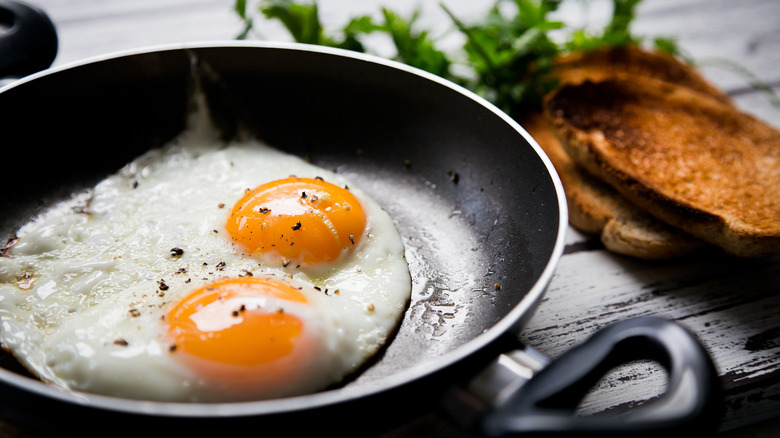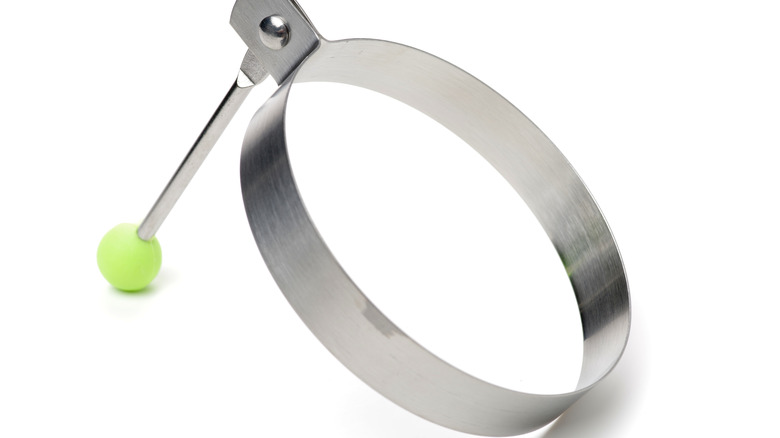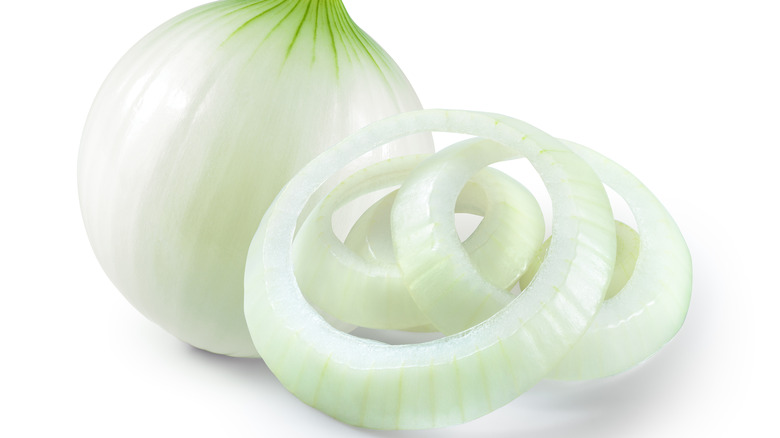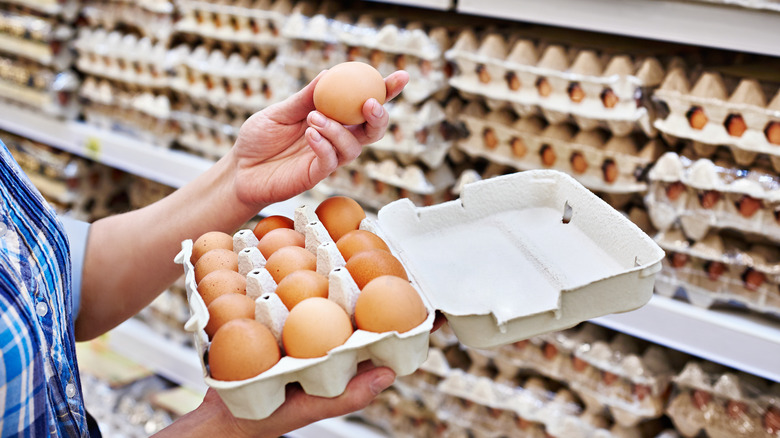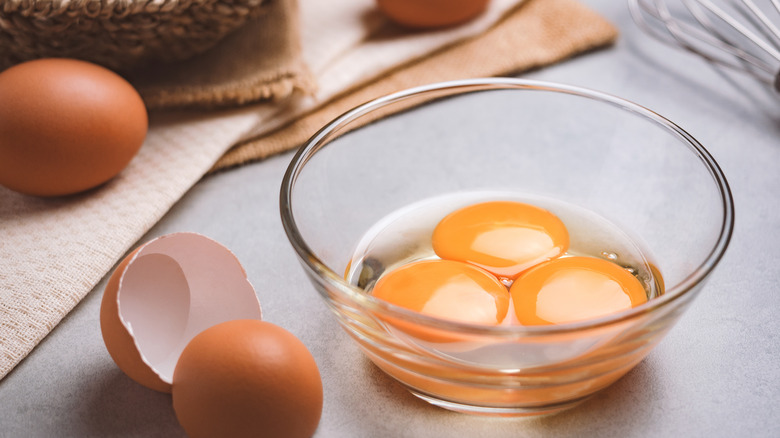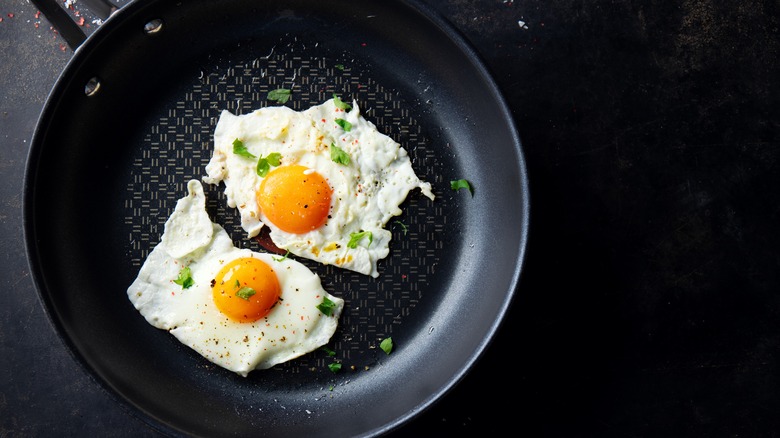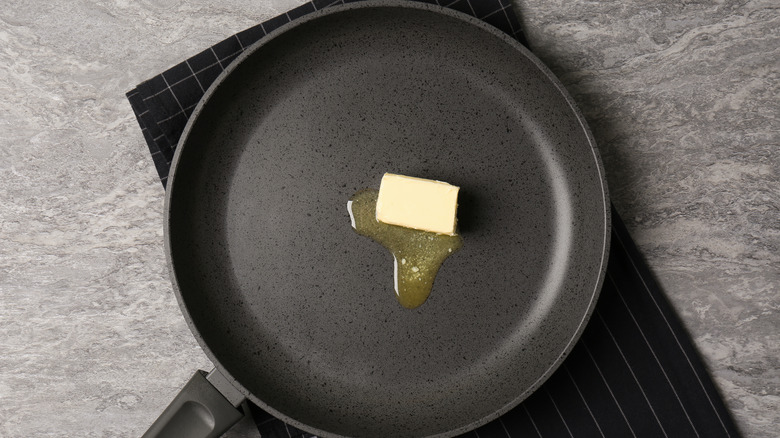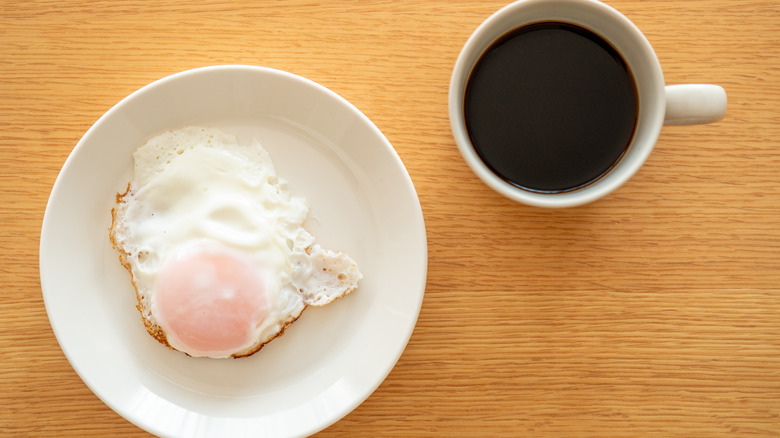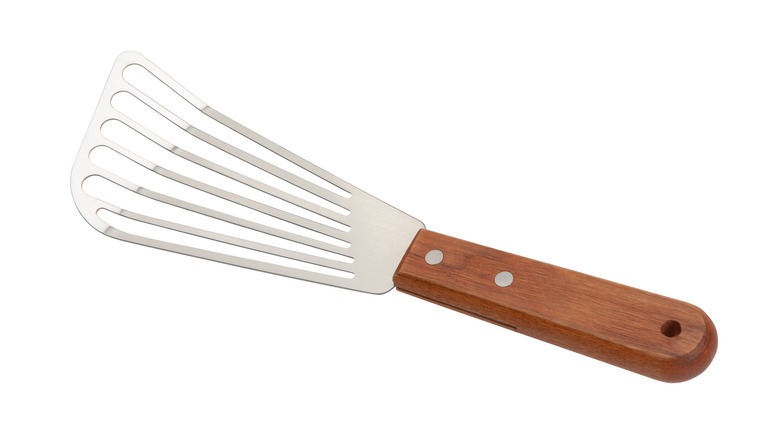9 Tricks To Prevent Fried Eggs From Spreading
There's nothing like having a perfectly fried egg for breakfast. Whether you like to eat it on toast, solo, or in a breakfast sandwich, a fried egg is a staple for a reason.
That's why it's such a bummer when it doesn't work out right. Eggs that are undercooked or overcooked can quickly ruin a meal — and so can eggs that don't hold their shape well. An egg that spreads out too much might be difficult to fit on toast or a sandwich, or may inadvertently lead to a broken yoke. Sometimes it might come about from an attempt to crack it that goes wrong, leaving you scrambling to pick out the shell before the egg starts to set in the pan.
Fortunately, there are a number of trusted ways to keep an egg from spreading. Some of these are pretty common in restaurants, where perfectly frying eggs has to be done with factory-like precision. Others are unique hacks that — maybe sometimes surprisingly — can help avoid unnecessary spread. Read on to learn about handy techniques to prevent fried eggs from spreading.
Use an egg ring
Looking for a tried and true way to prevent eggs from spreading? Do it like the professionals and use an egg ring. Egg rings are pretty ubiquitous in restaurants where fried eggs are an everyday part of the menu. They are pretty simple, typically consisting of a stainless steel or silicone ring that acts as a mold for an egg. You drop the raw egg into the mold, and it quickly fills out the dimensions of the ring (which can be 3 inches, 4 inches, or other sizes) as it cooks, ensuring an even circle that is easy to flip without making things messy or breaking the yolk.
Egg rings are typically inexpensive, and because they're so small, are easy to clean. While they don't necessarily guarantee a perfect egg every time (as you'll see below, there are a few important tips to bear in mind to prevent spreading) they can go a long way toward making any fried eggs neat and nicely contained.
Make your own egg ring
Sure, you can buy a stainless steel egg ring. After all, they're pretty affordable. But doing so might not even be necessary, because you may have all the tools you need to make your own egg ring — right at home.
Interestingly enough, an onion or bell pepper cut into a ring can work similarly to a manufactured egg ring, effectively trapping the cooking egg inside and helping it keep its shape. The two vegetables aren't necessarily equivalent — onions are more likely to offer a perfectly round mold, while a bell pepper will give you a slightly irregular, but definitely usable, shape. Also, bear in mind that both may impart a little flavor (and in the case of a pepper, a little color), so it's important to be prepared for that. But if you're looking to keep your egg well-contained and want to use something you already have on hand (and something edible, no less), a roughly half-inch round slice of either vegetable should get the job done.
Fry your egg in a smaller pan
It might seem obvious, but it's easy to overlook: A larger pan means that an egg has more opportunity to get messy. In other words, eggs can't spread if they have nowhere to go.
Accordingly, a pretty simple way to keep your fried eggs from spreading is just to use a small pan, of which there are plenty on the market. A one-egg pan is designed for just that, and while it won't always give you a perfectly shaped egg, there will be an inherent limit to how far an egg can spread.
A small pan also allows room for experimentation: You might find that a pan of a certain size is great for frying two eggs and keeping them neatly contained next to each other. Or you might find yourself with a whole new propensity to making single-serve omelets. Whatever your personal preference, a mini pan can be a great investment if you're regularly frying eggs and want to keep things neat.
Cook with room temperature eggs
An egg is an egg, right? Why should its temperature matter?
Actually, you might be surprised. The temperature to store (and use) eggs is, in some ways, a matter of debate. While egg refrigeration is the norm in the United States, it's actually not in Europe. That largely has to do with how the eggs are processed: To combat salmonella, American eggs from large producers are washed and a coating called a "cuticle" is removed, so they must be subsequently refrigerated to keep out bacteria; in Europe, the washing process does not occur, but chickens are vaccinated against salmonella.
This isn't the only point of debate: You may have noticed that many recipes call for using room-temperature eggs, both for baking and cooking. When it comes to frying them, room-temperature eggs are more apt to cook more evenly when it comes to both yolk and whites. If your eggs are too cold, your breakfast might still turn out okay, but you may have to flip the egg more often or spend more time waiting — increasing the chances that it sticks, the yolk breaks, or the egg otherwise spreads more than you want.
Crack the egg into a bowl first
Whatever type of eggs you're making, it's a good idea to avoid cracking them straight into the pan. Why? No matter how good you are at cracking eggs, there's always a chance for a mistake. Maybe you'll misjudge the surface you're cracking it on. Maybe the egg you're cracking has a particularly hard shell. No matter the variable, it's going to be easier to keep an egg from spreading if you crack it into a bowl first (and be sure to crack in on a flat surface, as opposed to the side of the bowl).
This is true for a couple of reasons. First, you won't have to do two things at once — crack the egg, and then quickly and gingerly pour it just right into the pan. Instead, you can let it sit comfortably in a bowl, and then carefully (from a low height) slowly transfer it to a pan. Second, if you do make a mistake while cracking it, it's easier to neatly pick out any shell if the egg is in a bowl and not already cooking in a pan.
Carefully choose the pan material
Technically, you can fry eggs in almost any type of pan. So long as it heats up, it should get the job done. In practice, though, choosing your pan wisely is a good approach.
When it comes to frying eggs, a nonstick pan can be very handy. These pans are simple to use, and as the name implies, are much less likely to have foods stick. This will make the egg frying process neater and will help prevent spreading. That said, nonstick pans do sometimes get a bad rap, due to their teflon coating. A chemical called PFOA used in older pans does have some health risks, and overheating teflon comes with risks of its own. While the quality of a given nonstick pan is definitely a factor, and newer pans are safer, some people do prefer other cookware.
If you'd like to avoid nonstick pans altogether, a ceramic pan, or a cast iron, can definitely work well. Just note that both will be more sensitive to using enough oil, and sometimes a cast iron can slightly discolor eggs due to a reaction between iron and sulfur, though this is really only an aesthetic concern.
Use sufficient butter or oil
Speaking of using enough oil, this step is always important when frying eggs, especially if you're not using a nonstick pan. It does take some time to get the hang of exactly how much to use. After all, you do not want an overly buttery or oily egg — that can quickly become unappetizing. But a sufficient coating of oil will make all the difference when you go to fry your eggs. An egg can stick to a pan quickly, and once that process starts, spreading will be the least of your concerns. "Freeing" the egg will almost invariably mess up a meal, forcing you to make impromptu scrambled eggs, or otherwise making your food pretty messy, pretty quickly.
Accordingly, it's usually best to be on the safe side and ensure that there's enough oil in the pan so sticking won't be a concern.
Cook at medium heat
Some days you're just in a rush and you want your food cooked as quickly as possible. So just turn up the heat, right?
Not so fast. Cooking temperature plays a critical role in how foods turn out, and eggs are no exception. Cooking eggs at too high a temperature can cause a number of problems — for one, they may be more prone to sticking (particularly if you haven't used enough oil). But they also simply won't cook as evenly. The egg yolk doesn't cook as fast as the egg white, and if the heat's too high, the white may be rubbery by the time the yolk is done. So you may end up having to improvise — breaking the yolk, for instance, and spreading it around to make it cook faster — which will force the egg to spread out or will otherwise aesthetically ruin a meal.
Even, medium heat is therefore your best bet to perfectly fry your egg.
Flip with a fish spatula
Let's say you evenly heat up a pan, perfectly crack an egg into a bowl, deftly lower it into the pan, let the egg cook on one side, and then — when it's time to flip it — you mess it up! It's not uncommon. Flipping an egg can be awkward. Depending on the shape of the pan, it might be hard to get under it. Or if you jump the gun, you may end up flipping it too early.
Truth be told, it takes some practice and experience to perfectly fry an egg, and ultimately there's no way around that. But one tool that can smooth the process is a fish spatula. For those who are unfamiliar, a fish spatula is a type of long, slightly-angled spatula with long slots in it, which can help more easily get into and under foods. And it's not just good for fish. Anything that requires deftly flipping something delicate will benefit. As Chopped host Ted Allen told People Magazine, "it's great for flipping, stirring, cutting, and getting that first brownie or piece of lasagna out of the pan." Try it and see how much it helps with breakfast.
